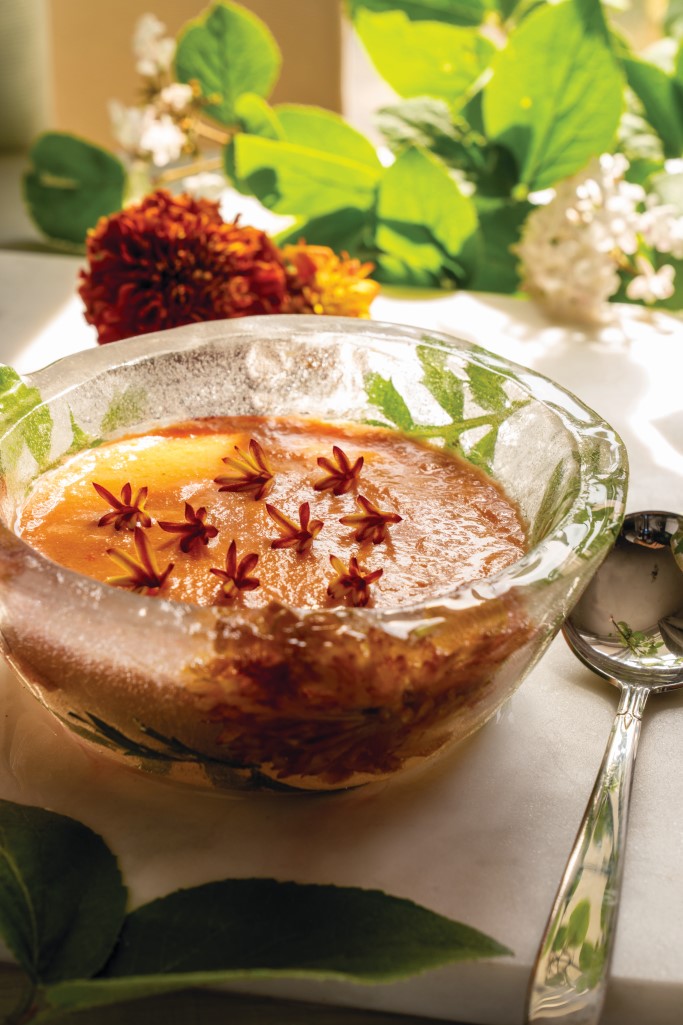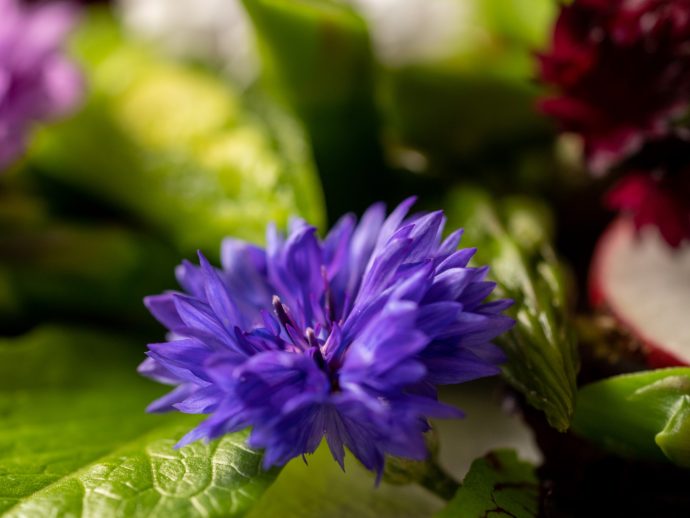Cook with edible flowers
Look to edible flowers to add beauty, flavor, and elegance to healthy seasonal dishes. These recipes will help you create not only pretty plates but delectable meals, perfectly suited for summer eating.
Whether you find them in your own garden or at the farmers’ market, make sure you’re using edible flowers that are grown specifically for eating. Avoid ornamental flower nurseries and seek out a reputable edible flower grower; ask them how they treat flowers to make sure they’re not sprayed or treated with chemicals of any kind. While “found” flowers can be both beautiful and tempting, leave them for looking at, unless you’re sure of their origins.
Mixed Greens with Pea, Asparagus, Sorrel, Radish, and Bachelor’s Buttons
Pretty on the plate, this salad of delicate greens contains bright, juicy, tart sorrel; crisp radish; and delicate bachelor’s buttons. If you can’t find bachelor’s buttons, you can use nasturtium or violas.
Bachelor’s button vinegar
8 to 10 bachelor’s button flower heads
1/3 cup (80 mL) apple cider vinegar
1 Tbsp (15 mL) Bachelor’s Button Vinegar
2 Tbsp (30 mL) olive oil
1 tsp (5 mL) honey or maple syrup
20 young asparagus spears
5 oz (140 g) mixed seasonal baby greens
10 to 15 sorrel leaves (optional)
1 cup (250 mL) sliced radish
1 cup (250 mL) snap peas
15 to 20 bachelor’s buttons or other edible flowers such as violas, for garnish
For Bachelor’s Button Vinegar, in Mason jar, combine bachelor’s buttons and vinegar. Close lid and store in a cool, dark place for 24 hours.
For dressing, in small Mason jar, combine 1 Tbsp (15 mL) of Bachelor’s Button Vinegar with olive oil and honey. Shake well and set aside.
In large pot of boiling water, blanch asparagus spears for 2 minutes and remove to large bowl of ice water to stop the cooking process. Drain and dry thoroughly. Cut each spear into 2 in (5 cm) pieces.
In large bowl, combine greens, sorrel (if using), radish, snap peas, and dressing. Arrange on large platter with asparagus, strewing bachelor’s button flowers overtop.
Serves 6
Each serving contains: 121 calories; 4 g protein; 7 g total fat (1 g sat. fat); 12 g total carbohydrates (5 g sugars, 4 g fiber); 25 mg sodium

Tomato, Watermelon, and Marigold Gazpacho
When the heat of summer has you ready to wilt, this refreshing summer gazpacho with watermelon, tomatoes, and almond is guaranteed to cool you down. Avoid the bases or “heels” of marigold flowers, as they can be quite bitter.
10 marigold or calendula flowers
1/4 cup + 2 Tbsp (60 mL + 30 mL) olive oil, divided
15 oz (425 g) very ripe tomatoes (about 2 to 3 large)
2 in (5 cm) piece of dry baguette, crust removed
1/2 small red onion
1/4 cup (60 mL) almond flour
2 tsp (10 mL) sherry vinegar
1/2 cup (125 mL) cold water
1/2 tsp (2 mL) salt
1/4 tsp (1 mL) pepper
13 oz (370 g) watermelon, about 3 cups (750 mL) diced
Marigold blossoms, for garnish
Pull petals from marigold flowers; snip off and discard white ends. Place petals in small saucepan with 1/4 cup (60 mL) olive oil. Warm gently on low for 5 minutes. Remove from heat and allow oil to cool completely.

Once cool, blend oil in food processor on low speed to chop marigold leaves. Into Mason jar, pour marigold oil, close lid, and set aside in a cool, dark place overnight.
In medium-sized bowl, combine tomatoes, baguette, onion, 2 Tbsp (30 mL) olive oil, 2 Tbsp (30 mL) marigold oil, almond flour, vinegar, water, salt, and pepper. Allow to stand at room temperature for 30 minutes, stirring occasionally.
Into blender container, pour contents of bowl and puree. Add watermelon and blend on highest speed until smooth. Pour into individual serving glasses; garnish with a few drops of remaining marigold oil and a few marigold blossoms.
Serves 6
Each serving contains: 176 calories; 2 g protein; 15 g total fat (2 g sat. fat); 12 g total carbohydrates (6 g sugars, 2 g fiber); 233 mg sodium

Saffron Quinoa with Almonds and Currants
There’s one flower you may already have in your pantry. The thin red threads we know as saffron are the stigmas pulled from the center of the saffron crocus. Saffron brings bright color and subtle earthy and slightly grassy floral flavors to dishes and is frequently used in rice dishes of all kinds.
1/3 cup (80 mL) blanched, slivered almonds
1/3 cup (80 mL) just boiled water + additional 1 cup (250 mL) water
1/2 tsp (2 mL) saffron threads
1 Tbsp (15 mL) olive oil
3/4 cup (180 mL) chopped shallot
2 garlic cloves, peeled and crushed
1/2 cup (125 mL) grated carrot
1/4 tsp (1 mL) ground cloves
1/4 tsp (1 mL) cinnamon
1/3 cup (80 mL) white quinoa, rinsed and drained
1/2 tsp (2 mL) salt
1/4 cup (60 mL) currants
1 tsp (5 mL) orange zest
In dry saucepan, lightly toast slivered almonds until golden brown, stirring frequently. Pour onto plate to cool and set aside.
In kettle, heat water to 170 F (76 C), using green tea setting. In small bowl, pour 1/3 cup (80 mL) over saffron threads to make a saffron tea. If your kettle doesn’t have a temperature setting, allow a just-boiled kettle to stand for 5 minutes to cool the water slightly. Allow saffron to infuse for 10 minutes while you prepare remaining ingredients.
In medium saucepan, add olive oil and gently saute shallots and garlic on medium heat until soft and translucent, about 5 minutes. Add carrot, cloves, and cinnamon, and stir to combine. Add rinsed and drained quinoa to pot and stir for a few minutes to incorporate. Add salt, 1 cup (250 mL) water, and saffron tea; turn up heat and bring to a boil. Reduce to low and cook, uncovered, for 10 minutes, or until holes appear in the surface of quinoa. Add almonds and currants in a single layer over quinoa; cover and cook for a further 5 minutes, or until white endosperm of quinoa emerges. Remove from heat and let stand, covered, for a further 5 minutes.
When ready to serve, add orange zest, fluff with fork, stir gently to combine all ingredients, and serve on large, flat platter.
Serves 6
Each serving contains: 83 calories; 2 g protein; 5 g total fat (1 g sat. fat); 8 g total carbohydrates (1 g sugars, 1 g fiber); 205 mg sodium
By Helena McMurdo

